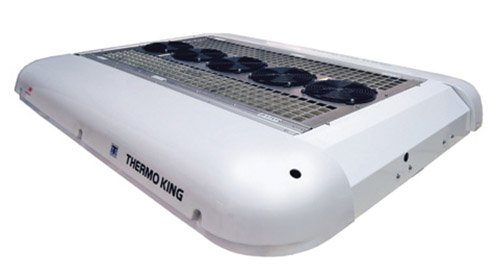
Air-conditioning innovations help the bus industry to comply
By Steve Johnson
Heating, ventilation and air conditioning (HVAC) system manufacturers have been instrumental in helping transit bus and motorcoach manufacturers meet changing federal Environmental Protection Agency (EPA) and state requirements in recent years – without sacrificing the passenger comfort and benefits that operators rely upon.
For example, new bus and motorcoach engines were required to meet new emission standards that took effect in 2010. To meet the standards, engine manufacturers added diesel particulate filters (DPFs), which took up valuable space on the rear of the bus above the engine. In the U.S. transit industry, the rear of the bus was far and away the most common location for the HVAC unit.
Roof-mounted HVAC units offer various benefits
The addition of DPFs created a dilemma for HVAC system manufacturers. They eliminated or reduced the space available for installation of a rear-mounted HVAC unit on many new models of buses and motorcoaches.
Leading original equipment manufacturers (OEMs) responded by developing highly efficient roof-mounted units that offer improved weight balance, lower noise levels, better air distribution and other benefits that positively affect operator efficiency and passenger comfort. The availability of roof-mounted HVAC units gives greater flexibility to bus and motorcoach designers and manufacturers.
Weight was a critical consideration for bus and motorcoach manufacturers, who challenged their HVAC system partners to move the air conditioning system to the rooftop without adding additional weight.
Earlier-generation rooftop units were typically 50 to 60 percent heavier than rear-mounted systems. Technology advancements and innovative designs enabled OEMs to come up with systems that met weight objectives at a comparable cost. In addition, today’s top-of-the line rooftop units meet or exceed the cooling performance of conventional rear-mounted units.
New refrigerant regulations, calling for a reduction in hydrofluorocarbons (HFCs), also took effect in 2010. These regulations banned the use of the R-22 refrigerant in new units, requiring OEMs to modify HVAC systems to accommodate more environmentally friendly alternatives. OEMs continue to innovate as federal and state environmental regulations evolve and new refrigerants are developed and introduced.
HVAC innovations help the industry comply
Modern HVAC systems use significantly less energy than previous-generation systems, putting less strain on the main engine and contributing to greater fuel economy, which translates directly to a smaller environmental footprint.
This year, motorcoach and transit bus manufacturers are working diligently to meet the federal 2013 On-Board Diagnostics (OBD) standards, which are designed to ensure that vehicle emission control technology is working properly and that greenhouse gas emissions are reduced to their required levels during every phase of operation.
Today’s advanced HVAC systems are equipped with sophisticated diagnostic capabilities that interface directly with the main bus OBD system, which communicates directly with the engine OBD system. This communication loop is particularly important since the HVAC system is the largest electrical load on a bus engine, requiring as much as 40 percent of the total available electrical energy the engine generates.
Additionally, the HVAC compressor can require as much as 30 horsepower each time the bus accelerates from the curb. Direct digital communications between the OBDs and HVAC system enables all to work together to keep the vehicle in compliance and provide the data the operator needs to ensure operational efficiency. Employing strategies to reduce the HVAC load on the engine is a key initiative for HVAC system manufacturers.
Bus and motorcoach manufacturers and their HVAC system partners continue to battle excess weight for a variety of reasons. Lighter vehicles are more fuel efficient and have less impact on the environment.
In addition, several states are considering legislation that would lift current transit bus and motorcoach exemptions to axel-weight restrictions, impacting both the purchase and operation of large buses and motorcoaches. By managing HVAC system size and weight, HVAC system OEMs are helping vehicle manufacturers prepare for this potential regulatory change.
Finally, HVAC manufacturers are keeping pace with transportation industry trends by developing state-of-the-art systems that are compatible with the alternative-fuel, natural gas and electric vehicles that are becoming an increasingly important part of many operators’ fleets. These innovative systems provide new levels of performance, efficiency and reliability while, most importantly, ensuring passenger comfort in every phase of operation.
